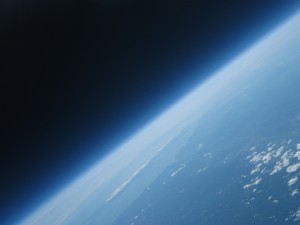Near-Space Photos on Shoestring Budget

"Earth" as photographed by Project Icarus' weather-balloon-toted camera at 93000 feet. (Photo used with permission. http://space.1337arts.com/) |
A recent CNN story highlights the spirit of ingenuity and determination that pushes the envelope of science and, in this case, the financial realities of space photography. Oliver Yeh, an MIT student, has a reputation among friends for being a "free thinker," but as Project Icarus proved, he's also got the science to put behind his big concept (and low budget) ideas.
With past scientific escapades like floating down-river on a raft of plastic bottles to his credit, Yeh reportedly didn't get a lot of support when he first sought out a partner to help with his newest project. But he didn't turn back. His idea was to launch a low-cost camera into near-space using bare-bones equipment: a weather balloon, a digital camera, a cell phone (for GPS tracking), hand warmers (to keep the phone battery from freezing), and a Styrofoam cooler (to protect the camera). Add in a small parachute for the drift back to Earth and a note taped to the outside of the cooler offering a reward for return of the assemblage if found, and Project Icarus was ready for near-space. After much planning, much calculating, and many "what if's," the team launched their balloon-toting camera on September 2, on a barebones budget that rang in at $148.
The story of the project reads like a good episode of a storm-chasers' program as the duo camped out the night before the launch and then waited... and waited... hoping for a signal that would let them know the camera had landed in one piece and not in a body of water. It's good reading. It's good science. And, as Project Icarus makes clear - space photography isn't solely in the purview of NASA.
The summary of the project in CNN's report makes the team's objectives and methods sound fairly straightforward. They planned to float a helium-filled weather balloon into the atmosphere. They predicted air pressure would cause the balloon to pop at approximately 17 miles up, and then the apparatus would parachute back to the ground. Throughout the flight, the cooler-encased and open-source programmed camera would snap photos every five seconds, recording the journey into "near-space." And, of course, the phone's GPS would let them track the launch and then find the gear once it touched down again.
Though it sounds like there were moments of doubt as the hours after the launch passed, things worked out as planned. The equipment was successfully located via GPS and retrieved, and the camera was full of striking photos. (The beauty of the near-space photos led them to set up the 1337arts website, which focuses on the intersection between art and science.)
In their own documentation of the project, the successful flight, and the surprisingly high-quality photographs from near-space, Yeh talks about the importance of a project like this as a touchstone for revitalizing interest in science among high school students. By demonstrating that it's possible to turn ordinary equipment into something out of this world, Yeh hopes to inspire a younger audience and their teachers.
Not surprisingly, reports of their successful flight spread quickly through Internet streams, and the team has been quick to warn that launching things into the atmosphere requires FAA approval.
While your students may not be launching to near-space anytime soon, Science Buddies has several relevant science fair project ideas which can let students begin to explore the kinds of concepts and parameters Yeh and his teammate thought through, strategized, and hypothesized in the months before the launch.
- Rocket Aerodynamics (Science Buddies' difficulty level: 5-9 )
- Using Weather Balloon Data to Map Atmospheric Temperature (Science Buddies' difficulty level: 6)
- Altitude and Elevation (Science Buddies' difficulty level: 4-5)
Categories:
You Might Also Enjoy These Related Posts:
- Plastics and Earth Day - Science Projects
- Arduino Science Projects and Physical Computing
- 10+ Robotics Projects with the BlueBot Kit
- 5 STEM Activities with Marshmallow Peeps
- March Madness Basketball Science Projects: Sports Science Experiments
- Women in STEM! More than 60 Scientists and Engineers for Women's History Month
- Explore Artificial Intelligence and Machine Learning with Student AI Projects
- 10 Reasons to Do the Rubber Band Car Engineering Challenge









